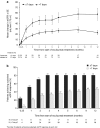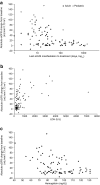Improved renal recovery in patients with atypical hemolytic uremic syndrome following rapid initiation of eculizumab treatment
- PMID: 26995002
- PMCID: PMC5316393
- DOI: 10.1007/s40620-016-0288-3
Improved renal recovery in patients with atypical hemolytic uremic syndrome following rapid initiation of eculizumab treatment
Abstract
Background: Eculizumab is approved for atypical hemolytic uremic syndrome (aHUS). Guidelines discuss the importance of prompt treatment. We report a post hoc analysis investigating the effect of baseline factors, including patient characteristics and time from the latest aHUS manifestation to eculizumab initiation, on change from baseline in estimated glomerular filtration rate (eGFR) and other outcomes.
Methods: Data were pooled from four phase 2, open-label, single-arm, prospective clinical studies of eculizumab for patients with aHUS. Multivariate regressions identified predictors of eGFR change from baseline. The proportion of patients achieving sustained eGFR increase (defined: ≥15 ml/min/1.73 m2 for ≥28 days) and platelet count normalization were evaluated 1 year post-treatment. Baseline characteristics and eGFR outcomes were summarized by time to treatment from last aHUS manifestation [≤7 days (n = 21) versus >7 days (n = 76)].
Results: Baseline eGFR were similar between groups. Multivariate regression analysis demonstrated time from aHUS manifestation to eculizumab treatment, age, baseline lactate dehydrogenase (LDH) and baseline hemoglobin were independently predictive of eGFR change from baseline. Mean eGFR change from baseline at 1 year was significantly higher in patients treated in ≤7 days than >7 days (57 vs. 23 ml/min/1.73 m2, p = 0.0098). After 1 year, 17/21 and 36/76 patients in the ≤7 and >7 day groups, respectively, achieved a sustained increase in eGFR. Mean time to platelet count normalization was similar between groups.
Conclusions: Younger age, higher baseline LDH and lower baseline hemoglobin were associated with greater eGFR improvements. Early eculizumab initiation led to improved renal recovery, demonstrating the importance of rapid diagnosis and treatment of patients with aHUS.
Keywords: Atypical hemolytic uremic syndrome; Chronic kidney disease; Eculizumab; Thrombocytopenia; Thrombotic microangiopathy.
Conflict of interest statement
Conflict of interest
Y. D. has received travel expenses and honoraria for educational purposes. G. A. is a member of the Scientific Advisory Board of the global aHUS registry supported by Alexion Pharmaceuticals Inc., and has received honoraria for giving lectures. J. W. and J. K. are employees of, and own stocks in, Alexion Pharmaceuticals Inc. H. H. has received lecture fees and travel expenses from Alexion, Baxter, NovoNordisk, Noxxon, Janssen and AstraZeneca. J. VW. is a member of the Scientific Advisory Board of the global aHUS registry supported by Alexion Pharmaceuticals Inc., and has received lecture fees and travel expenses from Alexion.
Ethical approval
All procedures performed in studies involving human participants were in accordance with the ethical standards of the institutional and/or national research committee and with the 1964 Helsinki declaration and its later amendments or comparable ethical standards.
Informed consent
Informed consent was obtained from the individual study participants for the original study. The current manuscript reports a post hoc analysis and additional consent was not required.
Figures


References
-
- Campistol JM, Arias M, Ariceta G, Blasco M, Espinosa M, Grinyo JM, Praga M, Torra R, Vilalta R, Rodriguez de Cordoba S. An update for atypical haemolytic uraemic syndrome: diagnosis and treatment. A consensus document. Nefrologia. 2013;33:27–45. - PubMed
-
- Fremeaux-Bacchi V, Fakhouri F, Garnier A, Bienaime F, Dragon-Durey MA, Ngo S, Moulin B, Servais A, Provot F, Rostaing L, Burtey S, Niaudet P, Deschenes G, Lebranchu Y, Zuber J, Loirat C. Genetics and outcome of atypical hemolytic uremic syndrome: a nationwide French series comparing children and adults. Clin J Am Soc Nephrol. 2013;8:554–562. doi: 10.2215/CJN.04760512. - DOI - PMC - PubMed
-
- Noris M, Caprioli J, Bresin E, Mossali C, Pianetti G, Gamba S, Daina E, Fenili C, Castelletti F, Sorosina A, Piras R, Donadelli R, Maranta R, van der Meer I, Conway EM, Zipfel PF, Goodship TH, Remuzzi G. Relative role of genetic complement abnormalities in sporadic and familial aHUS and their impact on clinical phenotype. Clin J Am Soc Nephrol. 2010;5:1844–1859. doi: 10.2215/CJN.02210310. - DOI - PMC - PubMed
MeSH terms
Substances
LinkOut - more resources
Full Text Sources
Other Literature Sources
Molecular Biology Databases
Research Materials
Miscellaneous

